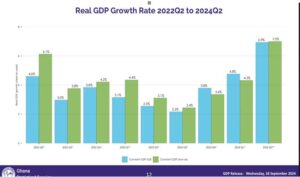By Ebenezer Chike Adjei NJOKU
The economy expanded by 6.9 percent year-on-year in the second quarter (Q2) of 2024, according to provisional data released by the Ghana Statistical Service (GSS).
This represents a significant improvement from 2.5 percent growth recorded in the same period last year, signalling a broad recovery across key sectors such as mining, agriculture and services.
The report highlights that real Gross Domestic Product (GDP), excluding oil and gas, increased by 7 percent in Q2 2024 compared to 3.1 percent in 2023 Q2. On a quarter-on-quarter (QoQ) basis, seasonally adjusted real GDP grew by 1.6 percent; up from 1.2 percent in the first quarter of 2024 and indicating steady economic momentum.
‘Mining carries Gold Coast’
The industry sector recorded the strongest performance with real GDP growth of 9.3 percent year-on-year (YoY), mainly driven by the mining and quarrying sub-sector which expanded by 14.8 percent. The oil and gas component also contributed to this growth, with a 5.8 percent increase in production.
Other industrial activities such as construction and manufacturing also showed positive outcomes. Construction grew by 8.4 percent YoY, while manufacturing increased by 3.9 percent. However, the water supply and waste management sub-sector contracted by 9.6 percent – reflecting challenges in infrastructure that tempered the industrial sector’s overall performance.

Nonetheless, the services sector continues to be the largest segment of Ghana’s economy, accounting for 44.2 percent of GDP. The sector grew by 5.8 percent year-on-year in Q2 2024, driven by a 12.8 percent expansion in the information and communication sub-sector.
Other sub-sectors, including financial and insurance activities (up 7.6 percent) and public administration and defence (up 5.7 percent), also recorded solid growth. However, certain areas within services like personal service activities contracted by 3.1 percent year-on-year, indicating uneven performance within the sector.
The information and communication sub-sector’s steady expansion reflects increasing growth of the digital economy, which has been supported by recent government policies. While the services sector overall remains a key driver of economic activity, specific areas such as personal services continue to face challenges.
The agriculture sector saw a moderate growth of 5.4 percent YoY in Q2 202, which represents 23.6 percent of GDP. The crops sub-sector, the largest within agriculture, recorded a growth rate of 6.4 percent; largely due to improved food crop production.
However, forestry and logging contracted by 5.2 percent, continuing a trend of declining performance in recent quarters. Cocoa production, an important component of agricultural exports, saw a significant drop – contracting by 26.2 percent and reflecting ongoing difficulties in the sector, including adverse weather and pest infestations.
Consumption and Investment Trends
On the expenditure side, household consumption was the primary driver of GDP growth, increasing by 8.5 percent YoY in Q2 2024. This growth was supported by rising incomes in agriculture and services, as well as greater access to credit.
Government consumption increased by 2.1 percent, though gross capital formation – a measure of investment in fixed assets – fell by 3.1 percent. Additionally, net exports declined by 59.2 percent, driven by lower demand for Ghana’s exports and a rise in imports; hence negatively impacting overall growth.










